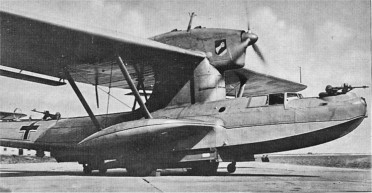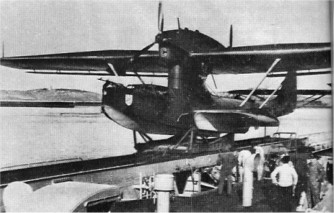Versions
B Project for a conversion kit between A and C (First project designs for the Do 18)
C V2 and V4 military version
D-0 Military version , pre-production batch
D-1 Military version , first production version. Two water rudders introduced during this series. Minor changes in equipment led to D-2
D-2 Military version
D-3 Military version
E Final designation for the civil Do 18 V3, V5, V6
F Designation for the V7
G Military version , Jumo 205D and improved armament
H Dual control trainer without armament
J At least 4 , the differens is unknown
N Several sources mention this version but there are no documents that can verify this ( Kössler/Mohr)
W The eighth D-3, Werk.Nr. 734 used for the World Record for Long Distance
L W rebuilt with BMW 132M engines
| Type |
H 4-seat trainer |
G 4-5 SAR |
D-1 4-seat reconnaissance flying boat |
| Engine |
2 Junkers Jumo 205C with 3-bladed variable-pitch propellers |
2 Junkers Jumo 205C with 3-bladed variable-pitch propellers |
2 Junkers Jumo 205C-4 with 3-bladed variable-pitch propellers |
| Dimensions |
Length , height , span , wing area , |
Length 19,40 m , height 5,4 m , span 23,7 m , wing area 98 m2 |
Length 19,23 m, height 5,32 m, span 23,7 m , wing area 98 m2 , |
| Weights |
Empty , loaded , max. take off weight |
Empty 7050 kg, loaded , max. take off weight 8500 kg (catapult 10600 kg ) |
Empty 6680 kg, loaded , max. take off weight 8500 kg (catapult 10000 kg ) |
| Performance |
Max.. speed , cruising speed , range , endurance , service ceiling , climb |
Max.. speed 250 km/h at sea level , cruising speed km/h , range 3500 km, endurance , service ceiling 4350 m , climb |
Max.. speed 250 km/h at sea level , cruising speed 190 km/h , range 3500 km, endurance , service ceiling 4350 m , climb to 1000 m 7 min. 30 sec. |
| Armament |
´None |
|
2 7.92 mm MG 15 machine guns, one in each of bow and dorsal positions Bombs: 2 50 kg or 2 100 kg bombs under starboard wing |
| Type |
E 4-5 seat Mailplane |
F 4-5 seat Mailplane |
L 4-seat engine testing, later military |
| Engine |
2 Junkers Jumo 205C |
2 BMW 132M with 3-bladed variable-pitch propellers dia. 3,4 m and 3,5 m |
| Dimensions |
Length 19,25 m , height 5,35 m , span 23,70 m , wing area 98 m2 , |
Length 19,25 m , height 5,35 m , span 26,30 m , wing area 111,2 m2 |
Length 19,40 m , height 5,8 m , span 23,9 m , wing area 98,7 m2
|
| Weights |
Empty 6260 kg , loaded , max. take off weight 10000 kg |
Empty 6500 kg , loaded 9000 KG , max. take off weight 11000 kg |
Empty 6560 kg , loaded 9500 KG , max. take off weight 10000 kg (Catapult start)
|
| Performance |
Max.. speed 260 km/h, cruising speed 220 km/h , range 5500 km, endurance , service ceiling 4300 m , climb |
Max.. speed 250 km/h, cruising speed 220 km/h , range 5500 km, endurance , service ceiling 4200 m , climb |
Max.. speed 260 km/h, cruising speed km/h , range km, endurance , service ceiling m , climb
|
In 1934, the Dornier Flugzeugwerke started development of a new twin-engine flying boat to replace the Dornier Do J "Wal" (Whale) in both military and civil roles. The resultant design, Do 18, retained the layout of the Wal, with a metal hull fitted with distinctive stabilising sponsons, and powered by two engines above the wing in a push-pull layout, but was aerodynamically and hydrodynamically more efficient. It was planned to be powered by two of the new Junkers Jumo 205 Diesel engines. Although heavy, these promised to give much lower fuel consumption than conventional petrol engines of similar power.[1]
The first prototype, the Do 18a, registration D-AHIS (and named Monsun by Deutsche Luft Hansa) flew on 15 March 1935, powered by two of the earlier 410 kW (550 hp) Junkers Jumo 5c Diesels as the planned Jumo 205s were not yet available.[2] It was lost on 2 November 1935 over the Baltic Sea during high-speed tests.[3] Three further prototypes followed, two (the Do 18d and Do 18b) being prototype military aircraft, and the Do 18c (later redesignated Do 18 V3), a civil prototype.[4]
The Do 18c was delivered to Deutsche Luft Hansa as a Do 18E civil transport (D-ABYM Aeolus), quickly followed by a further two aircraft, (D-AANE Zyklon and D-ARUN Zephir)[5] with a final Do 18E (D-AROZ Pampero) being built in 1938.[6]
A further civil Do 18 was the Do 18F, a modified aircraft with longer wingspan and higher weights built for extended-range flights. The sole Do 18F, D-ANHR, first flew on 11 June 1937.[6] It was later modified with 656 kW (880 hp) BMW 132N radial engines to test a possible upgrade for the Luftwaffe's aircraft, flying in this form on 21 November 1939 as the Do 18L. It suffered cooling problems, however, and further development of the radial powered Do 18 was abandoned.
Civil service
In 1936, Deutsche Luft Hansa started a series of endurance trials, culminating on 10–11 September when Zephir, flown by Flugkapitän Blankenburg with Deutsche Luft Hansa Director Freiherr von Gablenz as passenger, was launched by catapult from the seaplane tender Schwabenland at Horta, Azores, flying the 4,460 km (2,270 mi) to New York City in 22 hours 12 minutes.[5] Also on 11 September, Aeolus flew from Horta to Hamilton, Bermuda in 18 hours 15 minutes,[5] continuing to New York the next day. For the main leg of the North Atlantic the aircraft needed the help of the catapult on Schwabenland. On 22 September Aeolus returned to Horta in 17:50 h (3850 km). Zephir was catapulted on 28 September at Hamilton. Further flights to New York followed on 5–6 and 6–7 October and the return flights this time, 17 and 18 October from Sydney, Nova Scotia. The flying boats did not wait for their tender and went on to Lisbon and Travemünde.
In April 1937, D-ARUN Zephir and D-ABYM Aeolus started service on the South Atlantic mail route from Bathurst, now Banjul, Gambia to Natal, Brazil (3040 km). Catapult ships were based in Bathurst and Fernando de Noronha to allow the aircraft to cross the Atlantic carrying a full load of mail.
In June they were joined by V6 D-AROZ Pampero. Aeolus was lost on 30 July 1937, when it had to make an ocean landing due to engine problems and was heavily damaged when Ostmark tried to retrieve the plane. Pampero (20 August) and Zephir (29 January 1938) also had to make ocean landings. Pampero was lost at sea nearly without trace on 1 October 1938 with a crew of five.
Deutsche Luft Hansa's fifth aircraft was the only Do 18F V7 D-ANNE Zyklon, that first took to the skies on 11 June 1937. This was the only Do 18 with a wider span, which enabled it to stay in the air with one engine out. This was a special demand of Deutsche Luft Hansa. Zyklon was used over the South Atlantic between September 1937 and March 1939. The Do 18s crossed the South Atlantic 73 times.
Zyklon is not the aircraft that established the England to Brazil distance record from 27–29 March 1938 as often stated.
[citation needed] The record-setting aircraft D-ANHR was taken from the military production line and was specially prepared. It was flown as a builder's machine with a Deutsche Luft Hansa crew augmented by the works pilot Gundermann. On the way back to the South American station the seaplane tender Westfalen took the aircraft into the English Channel where it was catapulted to Brazil. On the record flight the conditions were not optimal and the Do 18 did not reach Rio de Janeiro as planned.
Military use
In Luftwaffe service, it was obsolete by the outbreak of World War II, but, as the only military flying boat, 62 (58 serviceable) Do 18s equipped a Staffel in each of five Kürstenfliegergruppen (Coastal aviation groups)[8] mainly on North Sea reconnaissance missions. In 1940 some squadrons changed their base to Norway. The vulnerable and underpowered flying boat was soon relegated to training and the air/sea rescue role. In the middle of 1941, only one squadron was still operational on Do 18. The Blohm & Voss BV 138 had superseded the Dornier.
A Do 18 was the first German aircraft to be shot down by British aircraft during the war, when one of a formation of three was caught over the North Sea by nine Fleet Air Arm Blackburn Skua fighter-bombers of 803 Naval Air Squadron flying from HMS Ark Royal on 26 September 1939. The flying boat was able to make an emergency landing but was sunk by the destroyer HMS Somali.


